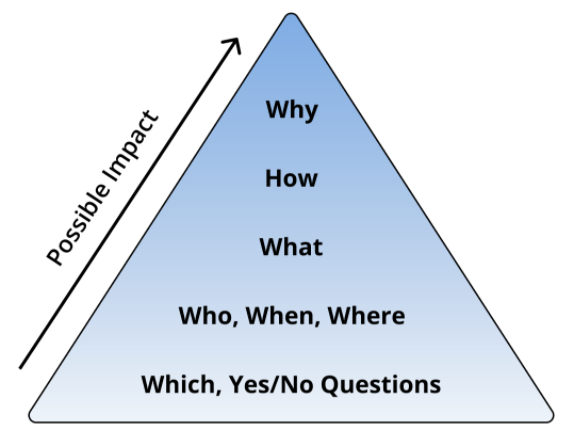From the classroom to the boardroom, our culture has a tendency to focus on the importance of providing the right answers, while paying less attention to asking good questions. This is one of the main challenges in product development, because questions can lead us down paths we didn’t even think existed. They open doors to dialogue and discovery, inviting connection and creativity.

A lot of what we know today owes to our curiosity and the questions we asked in the past. Children are known for asking questions to the point of annoying the adults in the room. As we grow older, becoming busy individuals whose minds are constantly being bombarded with external information, we often diminish our important habits of inquiry and curiosity.
As PMs, we know that our products are only as good as the questions they answer. So with that in mind, let’s explore some ways to include more impactful questions in the process of product development.
Different levels of questions
Not all questions have the same impact. If we look closer at the way questions are formed, we can spot patterns that make them more or less powerful. Words that stimulate reflection, generate curiosity, and challenge assumptions are more likely to engage the audience and promote powerful insights that can ignite change.

The triangle of impact, adapted from the “The Art of Powerful Questions”, illustrates well the possible impact of questions based on the way they are formed. Notice that it highlights the power of open-ended questions. They are designed to encourage more meaningful and complete answers when compared to closed-ended “yes/no” questions.
For example: Which of the following questions is likely to be more impactful to the listener? Which will stimulate more reflection?
- Do you like your job?
- What do you like about your job?
The first question encourages a short and single-word answer: yes or no. The second one creates space for thinking, allowing more meaningful information to be extracted from it.
Ultimately, there is no right or wrong question, but crafting your question based on what you expect to get from it can help you be more effective.
Powerful questions in product development
How powerful are the questions you and your team have been asking? Are you using them effectively to overcome the challenges of product development?
The best product leaders know that it is asking questions that push us to challenge our assumptions and ultimately improve our existing products, or build better ones altogether. While you can use the power of questions in any context, here are some key areas worth highlighting for PMs:
- Product Iteration & Analytics. Aimed to extract insights and information that will help understand the product and guide the next innovations that will make it better. Do our metrics say we’re on the right track?
- Business & Strategy. Where the big questions are asked. What’s the vision? Where are we headed? How are we going to win the market?
- Customer Interaction. Valuable information exchanged with the most important people here, the customers. It depends on the audience, the channels, and what you hope to find out, but lots of opportunities to use the power of question here to understand more about the basic question of How can we better solve problems for users?
- Team Engagement. How well does the team know each other? Is the team open to understanding different viewpoints? Is the team communicating effectively? How is feedback given and received? Questions here can help bring people together and to influence the sense of connection.
- Processes & Operation. As processes and operations require continuous improvement, asking questions to help spot opportunities is a common resource.
And the list goes on. It is important to note that it’s not one person’s job; everyone plays an important role here.
Doing it together
Building and maintaining a culture that promotes curiosity and the habit of asking questions takes time and team effort. It’s important for leadership to take initiative to encourage teams to feel comfortable in speaking up, to challenge each other and to feel that questions are worth asking.
If you feel this might be a challenge for your product development team, there are some easy ways to get started. You can explore being open and intentional about moving towards that culture by using workshops or sharing sessions. And improving the way you listen and receive feedback from your team is extremely important.
Simply asking for general feedback by saying “Any questions?” might not inspire your team to share much. Getting a bit more specific is likely to bring more voices to the table. Try questions like “How does this sound?” and “What are we missing here?”, or asking individuals and departments directly for their feedback. Transparency and active listening are key for success.
Join the conversation
Now that I’ve got you thinking about the power of inquiry, what are the questions you will be asking next?
Join the conversation in the comments below by sharing your thoughts and favorite powerful questions. In my next post, I’ll ask you to consider one of the most important questions for a PM: Why does your product exist? Stay tuned.
About the speaker
Product-driven, result-oriented tech director, committed to growth and passionate about building tech products that are impactful and amuse its users. Experienced in developing product strategy, leading development & product teams towards product vision, and in directing and managing project implementation.